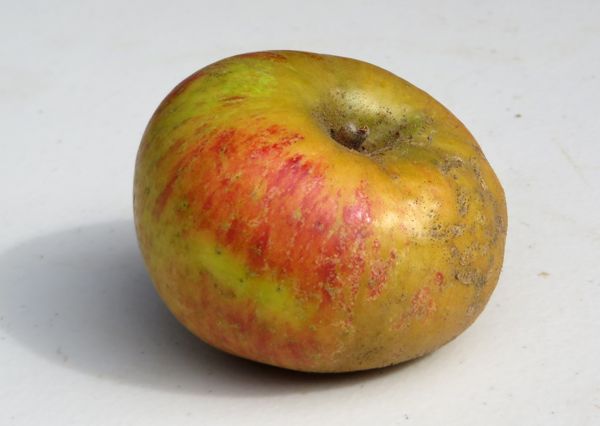 |
Hyperbole aside, the Everlasting enjoys a reputation as a keeper. And, it’s really good to eat.
My sample is small, oblate, and lopsided, but I saw larger examples. Most were broader than they were tall.
There's almost no ribbing on mine, but those ridges and bumps were more pronounced on some others.
Allen's Everlasting has a patchy orange blush with distinct red streaks over a yellow-green peel. It’s really quite striking; click on the photo for a better look.
A good third of the apple has a mustard-colored russet, and there are some spotty black discolorations that look like loose rows of ground pepper. Where not rusetted the peel is glossy.
Tan lenticel spots are hard to spot against that patchwork riot, but are most obvious in the blushed regions.
 |
| Another view |
Breaking crisp but also a little chewy, the flesh is a fine-grained creamy light yellow, fragrant and flavorful. Allen's is perfectly balanced between sweet and tart, but there is a good deal of acidity.
Flavors in that mix are berries, melon, and a little citrus, not distinct but all bound together. There is also a smooth sweet note akin to vanilla in this one.
 Finally the apple just feels very good in my stomach. Does that make sense?
Finally the apple just feels very good in my stomach. Does that make sense?
In short this apple bears many interesting and pleasant flavors and sensations, and I wish mine were larger and plural.
Is it anomalous to characterize an apple as an Irish Victorian? Allen's Everlasting dates from Ireland in the middle of the 19th century, according to various sources.
I love the looks of it--it has character. Hope I get to try it someday.
ReplyDeleteHi Adam. May I ask if you know around where this apple was grown? I ask because I just received some Allen's Everlasting scionwood but honestly don't know if it will ripen in my Zone 5ish climate.
ReplyDeleteHi Paul.
DeleteI got mine from the Monterey Bay chapter of the Californa Rare Fruit Growers. That is zone 9, I believe.
On its face, that is not encouraging for Zone 5, but you never know. It did originate in Ireland, where it was (obviously) good enough to merit cultivation.
thnk you Adam!
Delete